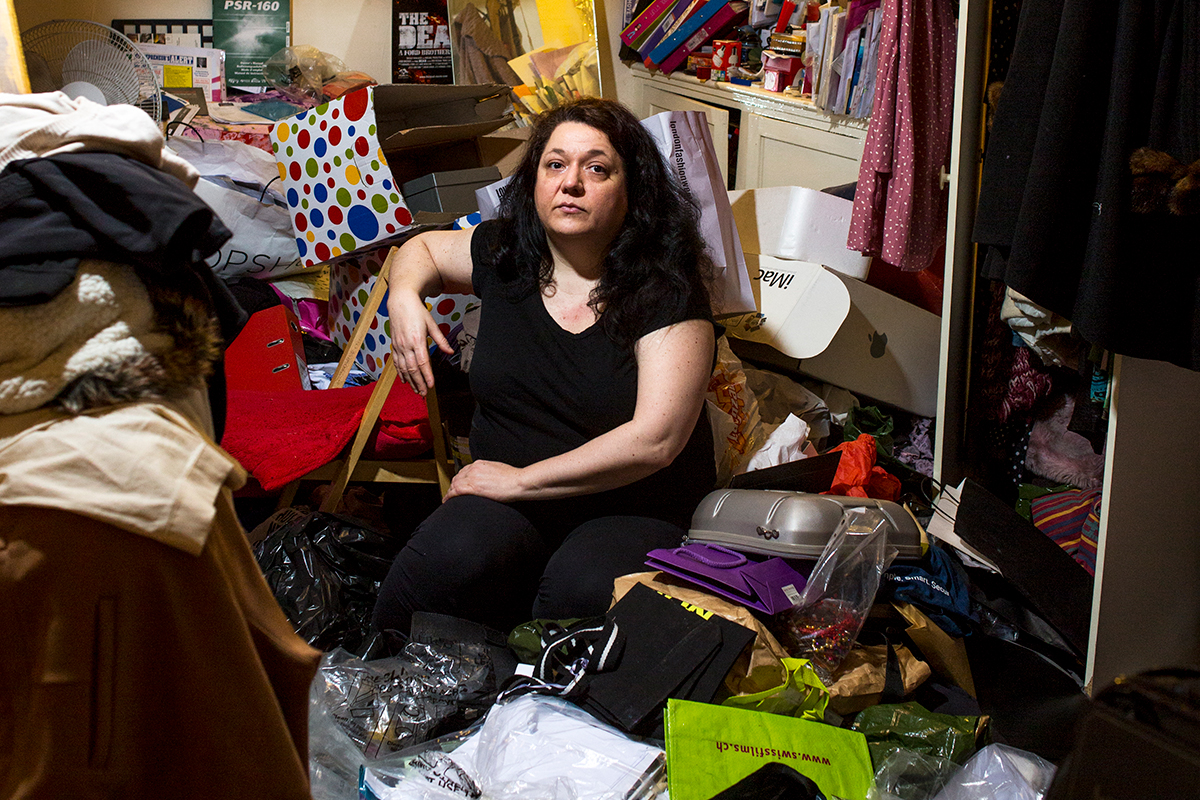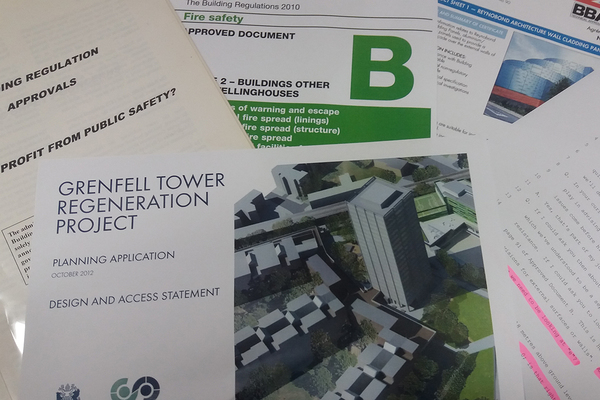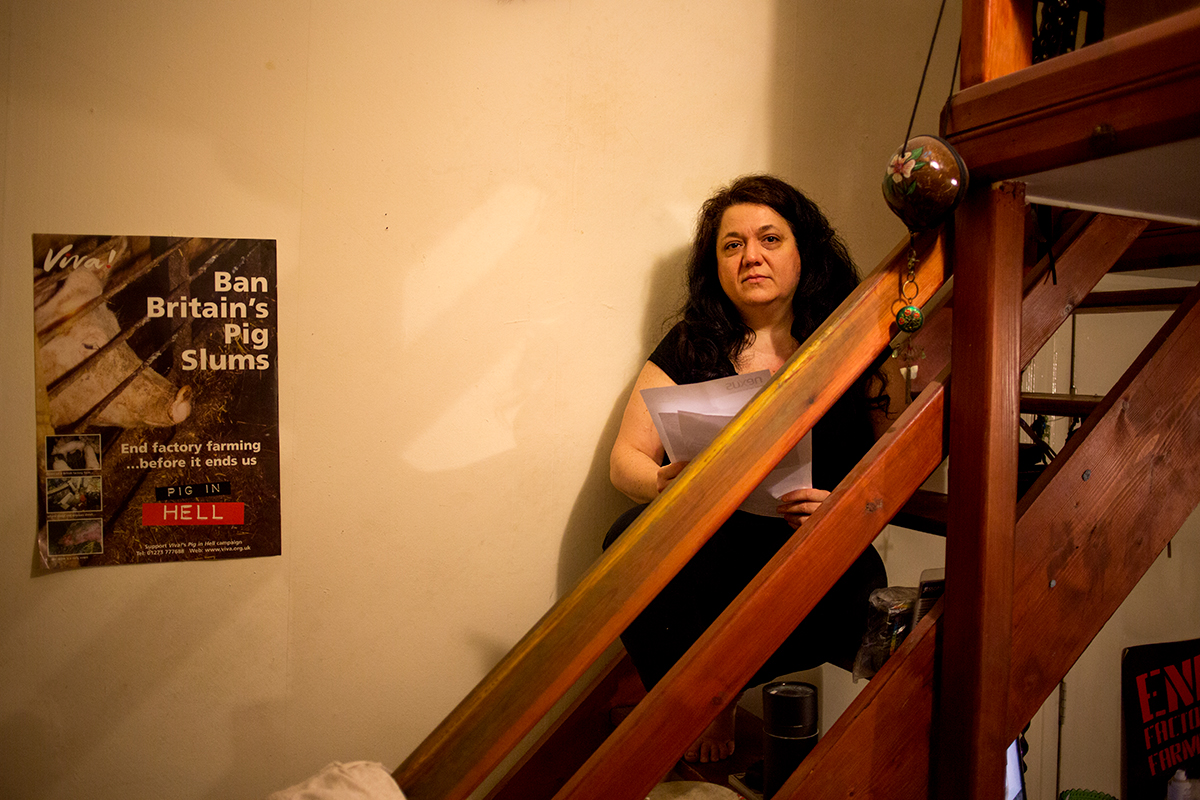You are viewing 1 of your 1 free articles
The disappearing HMOs
Houses in multiple occupation are often far from ideal lodgings – but a trend to convert them to more profitable houses is leaving residents with few options. Danielle Aumord reports. Photography by Tim Foster
Paola Berta in her small studio in Kensington, London
Linda Wade, Liberal Democrat councillor for Earl’s Court, is determined. She’s a woman on a mission to stop houses in multiple occupation (HMOs) in her ward being converted for other uses.
HMOs provide less expensive housing for people who cannot afford their own place in the private rented sector and are not eligible for social housing. Often they are run by private landlords, but some social landlords also operate HMOs. This type of housing is far from perfect, but for tenants its loss can be a severe blow (see boxes below).
Making tea at her Earl’s Court flat earlier this year, Ms Wade recounts how she spent Christmas trying to keep many residents calm.
“Within my ward there are about eight of these types of applications in the pipeline. I’m faced with potentially 80 to 90 people at risk of being made homeless because of planning applications to convert HMOs into self-contained units. HMOs are not perfect but they do in some cases represent an affordable option for low-paid workers,” she says.
She wrinkles her face in frustration. “Some of the tenants here wouldn’t be considered to have sufficient priority to gain housing points,” she says.
While there is a policy to try and protect HMOs in the borough and legislation that states landlords need a licence to operate, in practice losses are still occurring, she adds.
Inside Housing sent Freedom of Information Act requests to all the London boroughs, plus Newcastle, Birmingham and Bristol, to find out how common it is for HMOs to be converted.
Many responded to say they did not hold the information we requested but we did find a smattering of planning requests being granted that resulted in a loss of housing (see table).
Number of applications granted by councils to convert HMOs to other uses
| 2016 | 2017 | |
| Bristol City Council | 2 | 2 |
| Harrow Council | 1 | 1 |
| Redbridge Council | 1 | 1 |
| Hillingdon Council | 1 | 0 |
| Tower Hamlets Council | 1 | 0 |
| Hounslow Council | 0 | 1 |
| Haringey Council | 0 | 3 |
| Camden Council | 0 | 1 |
Source: Responses to Inside Housing Freedom of Information Act requests
Some councils have planning policies to protect HMOs. For example, recent planning applications granted for works on HMOs last year in Westminster did not result in any losses to housing this time but were simply to increase or reconfigure the units, a Freedom of Information Act request reveals.
A council spokesperson says: “HMOs are protected by policy so that their loss is rare. We’ve had this policy in place since 2007.”
Still, Karen Buck, Labour MP for Westminster North, told Inside Housing that she had one such case in 2016, which ended with the closure of a former hostel in Bayswater, run by the housing association Viridian.
Paola Berta, 44
Born in Italy, Paola Berta is Ako Ahmed’s neighbour (see below) and a big part of his support network despite having her own problems.
She has a heart condition and has been diagnosed with clinical depression. Ms Berta also has a long history of self-harm.
The floor cannot be seen in her flat because her possessions are strewn everywhere. The bed is a mattress on a hand-built-looking mezzanine level within the studio – while the kitchen and the bathroom are adjoined and look dirty with grime. There’s hardly any natural light in her cramped unit, where she’s resided since 2003.
She was referred to the managing agent by a friend after living somewhere else as a carer. “I was desperate to leave where I was living,” she says. “One night, someone coming directly from prison tried to break into the flat and my neighbour shouted at him and chased him away. I may even have escaped from a potential rape.”
Ms Berta is very animated while speaking: “Eventually he [the person she was caring for] wanted me to leave because he was looking to be moved into a bigger flat by his housing trust and he was worried that if it found out I was staying with him, he’d lose his tenancy.”
She has also been issued with an eviction notice, but Kensington and Chelsea Council has accepted a homelessness duty of care for her.
However, she’s unhappy with what the council has offered her. She tells Inside Housing that she wasn’t allowed to view a temporary flat she was offered in Leatherhead, Surrey, before making a decision about whether to accept it.
Ms Berta explains: “Also because I have a local community support network, including mental health professionals, it’s important for me to stay in the borough to be able to access them.”
Ms Berta is being referred to a mental health advocate. She has since received a bailiffs letter with a date for eviction – increasing her anxiety and leaving her finding it hard to process her thoughts around everything that is happening.
She says: “The reality of the problem is bigger than me. I suffer from severe anxiety, I’m distressed and feel extremely tired. My friends can see that I’m not as social or as friendly as I used to be. I’m very distressed.”
After the interview, Ms Berta was offered support accommodation by homelessness charity St Mungo’s.
“Sixteen occupants were left homeless. Westminster housing did try to assist with keeping the hostel as it recognises there is a shortage of this type of accommodation.
“Cities thrive when they offer a range of housing options suitable to the variety of needs of their populations,” says Ms Buck.
A spokesperson for Viridian says that the former tenants received compensation as well as advice on alternative housing options, and one tenant with an assured tenancy was rehoused.
Ako Ahmed, 51
“The council gave the landlord permission to kick me out. I’ll be sofa-surfing if Kensington and Chelsea Council don’t find me anywhere,” says Ako Ahmed, a British citizen from Kurdistan. “A friend referred me to the landlord. I’ve been living here for six years.”
He’s slim – balding – and shaking with fear as he talks to Inside Housing about his circumstances. Mr Ahmed’s studio flat is on the fourth floor in a HMO building with no lift, and because he walks using a walking stick he finds the stairs difficult to manage: “In January 2016, a car hit me and broke my leg. That year I had two operations and they put a metal pin in my leg. I’m due to have one more operation soon.”
He pays £250 rent per week, including council tax and bills to reside here on Warwick Road, in Earl’s Court. “I’ve been prescribed 45mg tablets of mirtazapine for depression. I am upset. I am very anxious about this situation with my housing,” he says, because of the threat to his housing arrangements.
Mr Ahmed’s only family live back in Kurdistan. As a result, he relies on his neighbours for help with tasks that he finds difficult such as carrying shopping.
He says: “Two months ago, the council asked me for a medical report. A caseworker found me a private studio flat in north London but because of my medical conditions, I couldn’t take it as it was too far for me to walk to catch public transport. Occasionally I ask about rehousing but they’ve told me to return when the bailiffs come.”
At the time of interview, 10 tenants had already been evicted and four were remaining although the landlord hasn’t actually applied for planning permission to carry out the works. Inside Housing made contact with the legal representation of Mr Ahmed’s landlord but has not received a response.
After the interview, Mr Ahmed decided to take a private studio flat in Hammersmith rather than waiting for Kensington and Chelsea to help him.
The spokesperson says: “We made the decision to close down 13 Palace Court as it is an old Victorian property, which needed significant investment to get to modern standards and we have been using the proceeds to invest in the provision of much-needed new homes in London.”
Kensington and Chelsea Council’s 2015 Local Plan also protects HMOs.
A spokesperson says: “We take the loss of HMO units seriously. We have a policy that states it is to ‘protect houses in multiple occupation except where a proposal concerns conversion into self-contained studio flats’.”
Helena Silva, 52
“I moved in during 1991 but I’m scared of my landlord kicking me out because it’s so expensive nowadays,” says 52-year-old Ms Silva.
A cleaner from Portugal, she lives in Earl’s Court with her husband who has diabetes.
“The landlord told me my home is worth £220 per week. If she wants to kick me out, she needs to give me two months’ notice,” she says.
She currently pays £155 a week, including bills.
Ms Silva appears frail and stutters when she tells Inside Housing that there’s no heating where she lives.
“My landlady has heating but she doesn’t put it on,” she says.
She also suffers from ill health – high blood pressure and breathing problems: “I’ve been coughing up blood for three months.”
Residents from 14 flats have to share two shower rooms. Besides Ms Silva’s place, all the other flats are bedsits that do not have a separate room for a kitchen, but even her home is very small – if she opens their fridge door, she isn’t able to open the oven.
With pride, she says: “Everything’s mine apart from one table the landlady gave me. I like my own decoration.”
When these points were put to Ms Silva’s landlady, Alexandra Denic, she said: “These comments must have been made a long time ago as I’m sure you would know if you have been there that the house is having a complete overhaul and being turned into studio flats.”
Most of the other tenants have been evicted and Ms Silva is worried about moving because most of her cleaning work is local: “I’ve been working for my longest client for 11 years.”
The planning application to convert the bedsits on the ground, first, second and third floors to eight self-contained studio flats was approved in December last year by Kensington and Chelsea Council.
At the time of the interview, Ms Silva was applying for a flat in an almshouse in Chelsea.
Meanwhile, a spokesperson for Waltham Forest Council highlights another dynamic within the conversion of HMOs to other uses: “Most addresses, in our experience, that were taken out of HMO use are returned to single family use.
“No planning permission is required for a change of use back to a single dwelling. In such cases, landlords would not be required to submit any application,” the spokesperson adds.
Based upon this planning policy, in 2017 Waltham Forest Council did not grant any planning applications for HMOs that resulted in the loss of housing.












